Home Safety Checklist For Cincinnati
Staying safe and secure in your home should be your topmost responsibility. But are you missing one or two big safety items? Take this home safety checklist for Cincinnati and find out where your home requires an update.
This guide begins with some whole-home safety techniques, and then we delve down to specific room ideas. Then, contact (513) 230-7397 or fill out the form below to talk to a security agent.
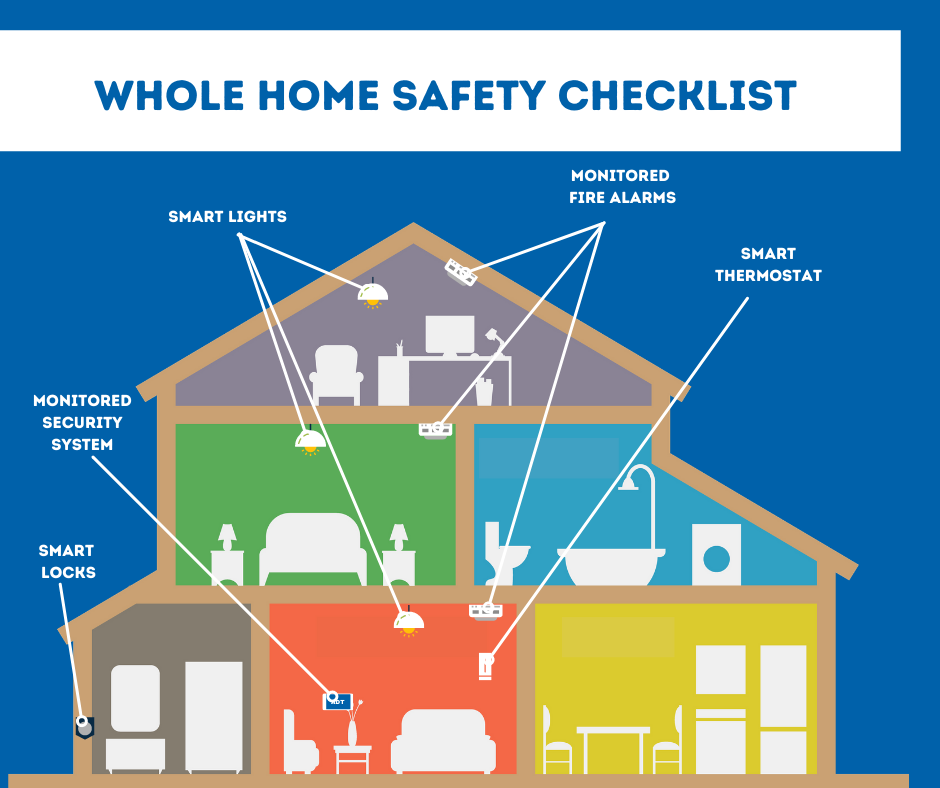
General Home Safety Checklist for Cincinnati
While you will want to use a individual room method for home safety in Cincinnati, there are some methods that work for the entire house approach. These items can talk together through a touchscreen hub, and often can react to one another. You might also control every one of your home safety devices through a smartphone app, such as ADT Control:
-
Monitored Home Security System: All your windows and doors should employ a sensor that warns your family to forced entry. As the alarm trips, your monitoring team responds to the call and quickly contacts the police or fire department.
-
Smart Lighting For Each Room: Sure, you can set your smart lights to become more energy-efficient. But smart lights can also help you remain safe during an emergency. Make your smart bulbs flash on when a sensor triggers to shoo off intruders or light a path to a outside location.
-
Smart Thermostat: Likewise, a smart thermostat in Cincinnati should save you 10%-15% in energy costs. But it also can flip on an exhaust fan if you have a fire.
-
Monitored Smoke Detectors: At the very least, you will have a smoke detector on each level. You can increase your fire game by utilizing a monitored fire alarm that looks for excessive smoke and heat, and notifies your 24/7 monitoring team when it detects a fire.
-
Smart Lock For Every Door: Every entryway that needs a keyed lock can use a smart lock. Now you may program codes to friends and family and receive notifications to your phone when they are used. Your locks can even automatically unlock, helping you to quickly leave if you have a fire or dangerous situation.
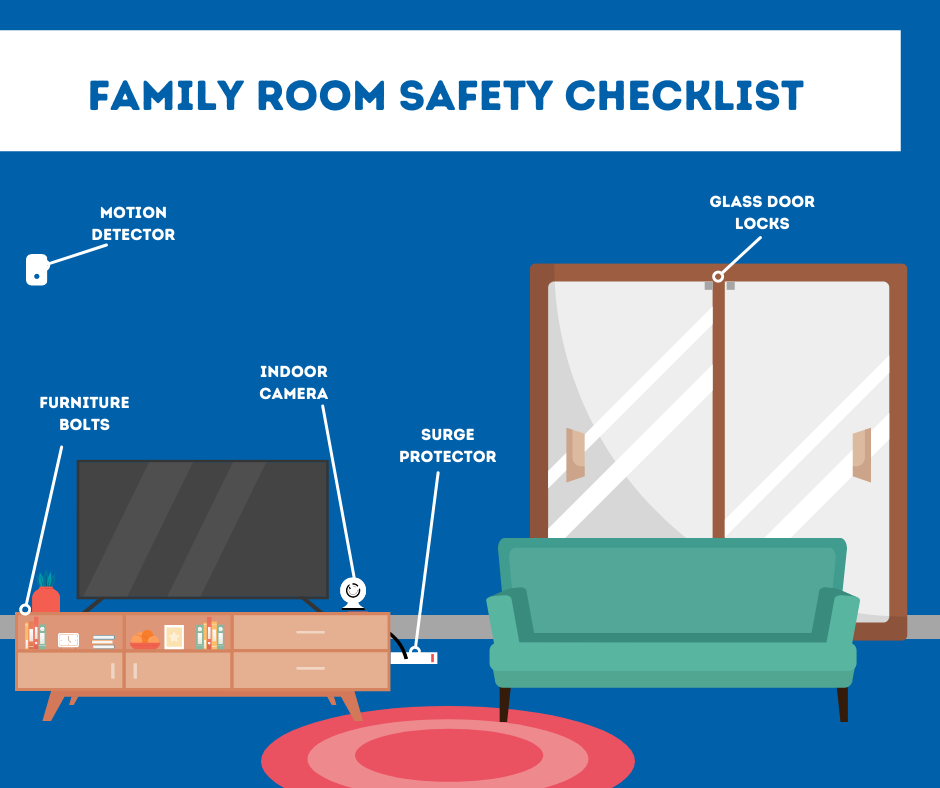
Family Room Safety Checklist For Cincinnati
You’ll hang out most in the living room, so it may be the perfect room to optimize your home safety. Electronics, like a TV or video game console, probably sit in your family room, making it a tempting area for burglars. Begin with placing a motion detector or indoor security camera in your room, then take a look at all these suggestions:
-
Motion Sensors: By putting in motion detectors, you’ll get a high-decibel alarm anytime they detect suspicious movement within your living room. You’ll want motion detectors that filter out pets or you’ll have your sirens go off every time your pet comes in for a bite of food.
-
Indoor Security Camera: An indoor security camera gives you an eye on your living room. Get live feeds of the area so you can know what’s downstairs without leaving your bed. Or chat with your kids in the room using the two-way talk feature.
-
Surge Protector/Outlet Maintenance: Make sure you protect all your electronics and stop overloading your circuits with a surge protector. For extra comfort, use a smart plug with anti-surge functionality built-in.
-
Furniture Attached To The Wall: If you have any small children, you’ll need to secure your entertainment center or other heavy furniture to your wall. This is extra crucial if your family room uses rugs or carpet that can make heavy objects extra wobbly.
-
Enhanced Locks For Sliding Glass Doors: If your family room has a glass door that slides out to a backyard, deck, or screened-in porch, you already know that the latch is usually thin. Put in an enhanced lock, like a metal bar or locks that bolt to the bottom and top of the door frame.
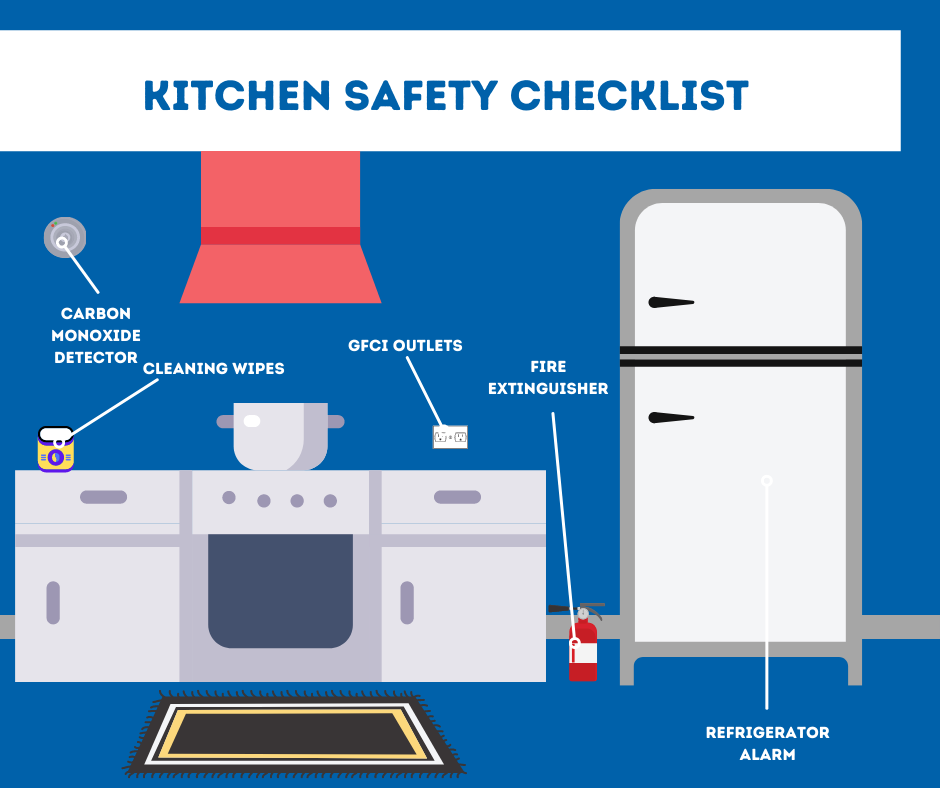
Kitchen Safety Checklist For Cincinnati
The kitchen has room for items that can bring safety and security to your home. Many of these objects should be easy to add and should be bought from the grocery store:
-
Fire Extinguisher: A fire can happen from a neglected pot or an errant grease splatter. Always keep a fire extinguisher at hand for any cooking emergencies.
-
GFCI Box On Every Outlet: A circuit interrupter outlet should be installed anywhere they’re by running water to ward off electrocution. That means the outlets close to your sink and kitchen counter. For 30 years, it’s been standard to have one circuit interrupter outlet per dedicated circuit. But each one of your outlets will go dead if any outlet detects a surge, so you’re going to want to have a single GFCI per outlet.
-
Monitored CO Detector: A carbon monoxide detector is advised for kitchens that have gas for the oven and stove. If your gas appliances malfunction, the carbon monoxide detector will emit a loud noise and contact your monitoring professional.
-
Cleaning Wipes Or Spray: The biggest safety issue in the kitchen is the viruses, bacteria, and cross-contamination from raw meat and vegetables. Always have disinfectant wipes or spray to scrub off your area before and after preparing food.
-
Refrigerator Alarm: The items in the refrigerator have to remain at a cold temperature to be healthy to consume. If you leave the fridge or freezer door open too long, then an alarm beep will remind you to close the door. Some refrigerators come with a pre-installed alarm, others won’t, and you’ll have to pick up a refrigerator alarm from the hardware store.
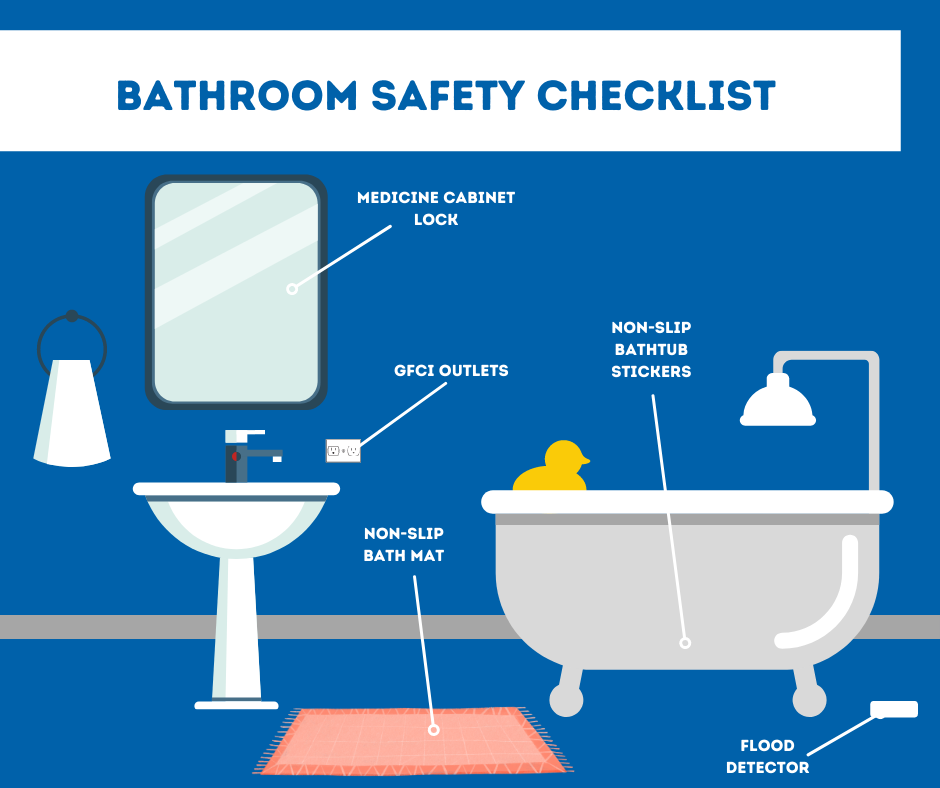
Bathroom Safety Checklist For Cincinnati
Just because you may not have a bunch of square footage in your bathroom, you will still have safety hazards. From flood prevention to anti-surge outlets, here are a few safety improvements for your bathroom:
-
Flood Detectors: A leaking sink or bathtub can lead to an expensive amount of water damage. Deal with leaks early with a flood detector and save yourself from renovating the whole bathroom.
-
Non-slip Bath Mats: A slip in the bathroom can be painful, causing cuts, sore joints, or broken bones. Or prevent these problems with a no-slip bathroom mat for after your bath or shower.
-
Textured Bathtub Strips: Another water hazard, a tub basin can be a slippery area to be on. It’s a good idea that each tub has some no-slip stickies so your feet and toes have a bumpy patch for stability.
-
Medicine Door Latch: If you have little children or a family member with memory complications, you need to take extra attention regarding medicine. Secure your prescriptions by installing a medicine cabinet with a locking latch.
-
Circuit Interrupter Outlet: While installing better outlets in the kitchen, you need to also put in a surge protecting circuit interrupter outlet on every bathroom circuit. These will stop the flow of the current if water splashes on them or they experience an unusual surge from a curling iron or hair dryer.
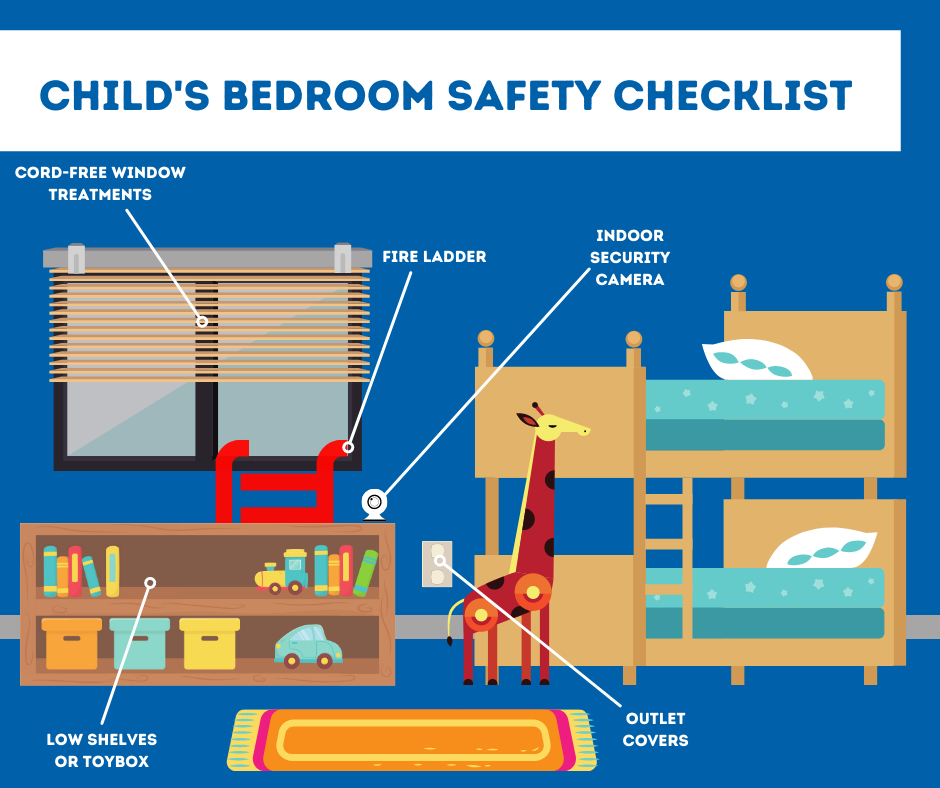
Child’s Bedroom Safety Checklist For Cincinnati
A child’s bedroom should balance safety with simplicity. If their window treatments or other things are safe but difficult to operate, then your kids may try dangerous activities -- like climb a chest of drawers -- to touch them. Try these simple, and safe, ideas:
-
Cord-Free Window Treatments: Safety professionals have identified window treatment cords a secret danger for both children and pets. Install motorized blinds or shades that your child can easily manage with a remote. Or even better, pair your shades to your ADT smart hub so they can raise on a schedule when the sun comes up, and close at night for extra privacy.
-
Indoor Security Camera: An indoor security camera sitting on your toddler’s desk or dresser can act just like a baby monitor that you can view with a mobile device. And if they want something, they can use the intercom talk button on the camera.
-
Outlet Covers: While every outlet should have protective covers on them to protect your little children, this is especially urgent in their bedroom. It’s the one place in your home where your toddler will most likely be solo without consistent parental supervision.
-
Window Safety Ladder: If you use bedrooms on above the first level, then you will want to have a window escape ladder. These should help a young one leave the house in case the stairway or lower levels are blocked off with fire. Just remember to go over how to use the ladder at least twice a year.
-
Toy Chest Or Low Shelves: It’s weird to look at a toy box as a safety device, but you’ll get it if you’ve ever stepped on a building block in your bare feet. A uncluttered floor let your child have a quick escape if there’s a safety or security event.
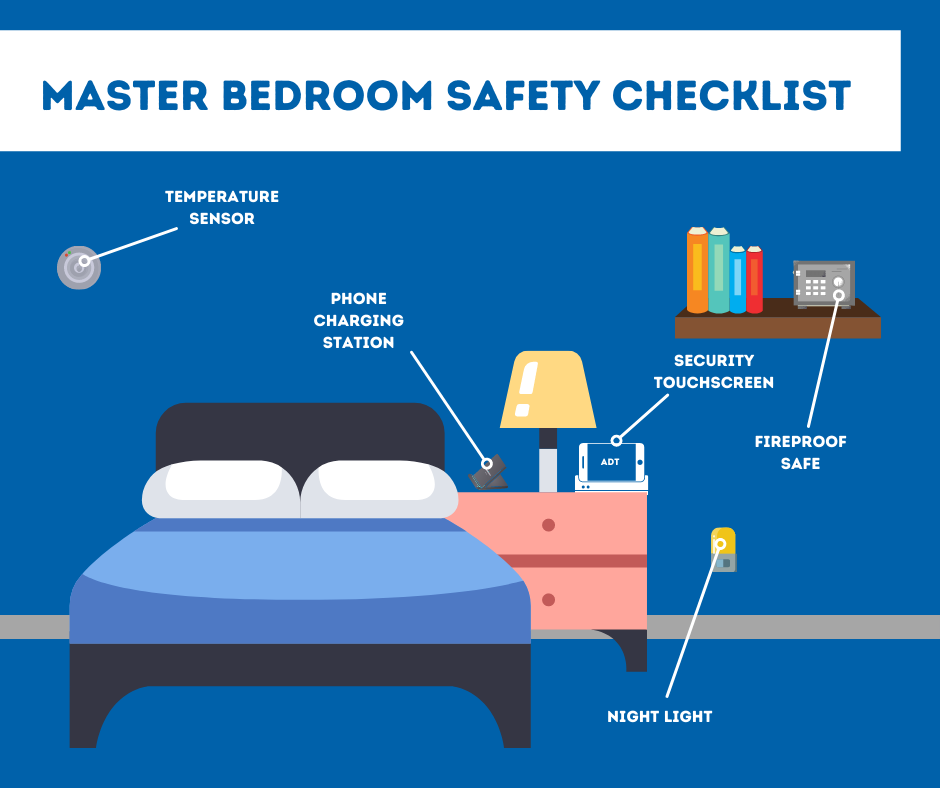
Main Bedroom Safety Checklist For Cincinnati
Your main bedroom should be a refuge, so let your safety components make you more responsive if you experience an emergency event. After all, being startled awake by a loud buzzer can be quite a shock.
-
Home Security Touchscreen: Having a smart hub on your bedside table lets you see what’s going on without jumping out of bed. You could always turn on your ADT smartphone app but, the HD touchscreen can be better to use when you’re yawning and finding your bearings.
-
Personal Charging Station: We rely on our smartphones for almost everything now alarm clocks, news readers, game machines, and maybe even phones. However, a depleted cell will cut us off from the outside world if something goes wrong. So, a charging station or cord becomes should be used nightly.
-
Nightlight/Smart Lights: A small light can calm you when you’re bolted awake from a siren or unexpected sounds. If you have trouble falling asleep with a nightlight, use a smart bulb in your bedroom. Then you can control light on-demand with a button push or voice direction.
-
Fireproof Lockbox: Store your essential paperwork like birth certificates, passports, or banking information in a fireproof safe. Your safe can be a big one that sits out of the way or a smaller handheld safe that you can snatch as you escape during a fire or break-in.
-
Heat Sensor: The drawback with bedrooms is that they might feel too hot or be cold since they are located far from the thermostat. A heat sensor will talk to your smart thermostat so you should have a comfortable, restful sleep at a wonderful temperature.
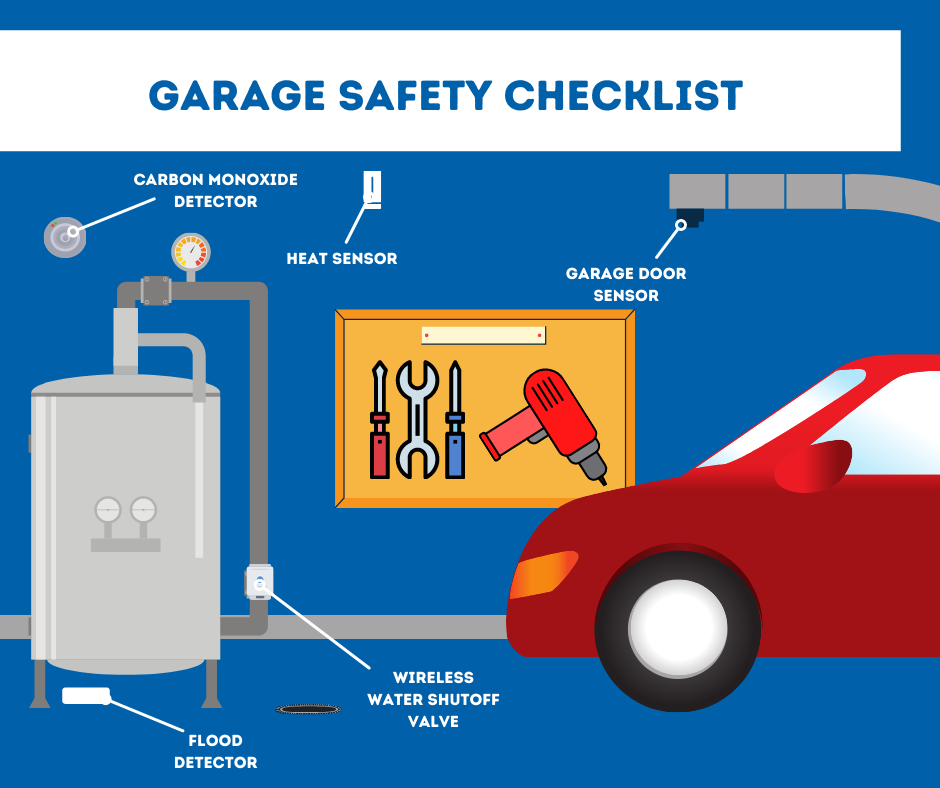
Garage/Basement Safety Checklist For Cincinnati
Most safety needs in the garage or basement have to do with your water heater or heating system. Finding problems before they start can stave away larger emergencies later on. So, as you look around your basement or garage, check over these safety items:
-
Water Sensor Or Sump Pump Alarm: Putting a flood sensor by your water heater and sump pump can prevent you from finding a lake when you go into your garage or basement. It’s sure better than sifting through a bunch of soiled storage boxes.
-
Carbon Monoxide Alarm: It’s beneficial to install a carbon monoxide detector in a place where a gas leak can happen. If you employ a gas furnace, try to hang a detector in the same place as your unit.
-
Wireless Water Shutoff Valve: If your flood alarm detects a plumbing leak or a busted pipe, then you need to shut off the primary water valve quickly. With a remote shutoff valve, you can block water flow from any mobile device. That’s nice when you’re out of town and see an emergency leak alert on your phone.
-
Garage Door Sensor: Leaving the garage open leads to all sorts of headaches. You can waste heat through that gaping hole, and critters or intruders can just walk in. A sensor will alert you to a forgotten garage door and allow you to close it with your phone.
-
Temperature Sensor: A temperature alarm in your garage or basement is a definite if you fret about frozen pipes. The temperature in these rooms can be wildly different than your main rooms of the home, so you will need to have a closer eye on the temp through your mobile app.
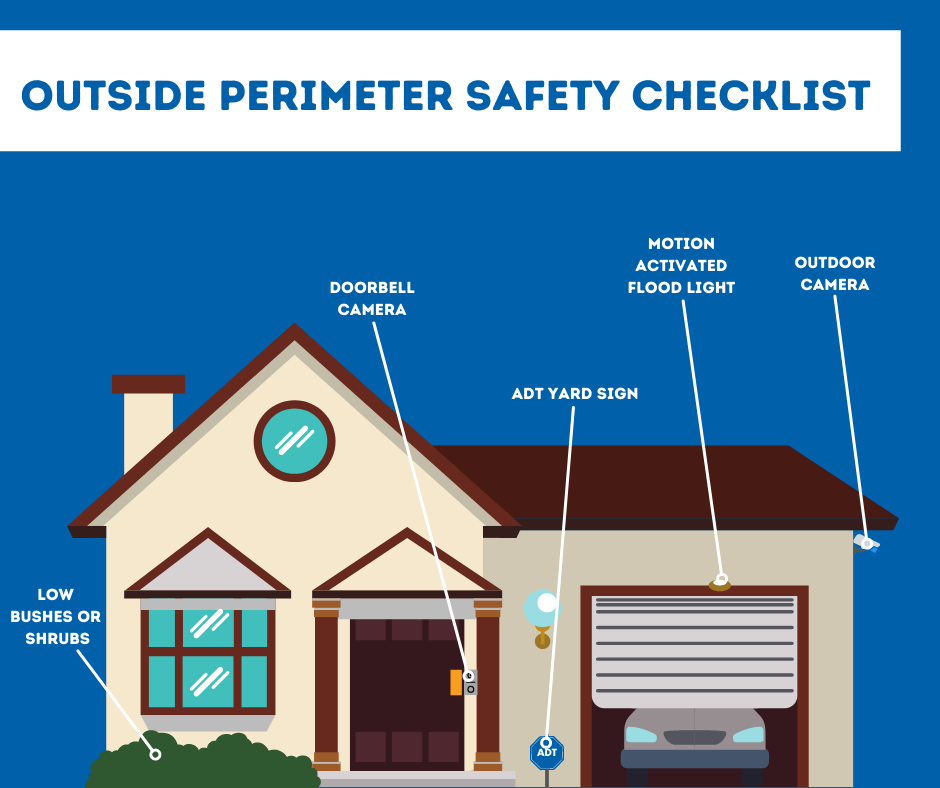
Outside Perimeter Safety Checklist for Cincinnati
Your landscaping, drive, and front step are just as imperative to secure as the interior of your house. Try this checklist to defend your perimeter:
-
Doorbell Security Camera: See who’s knocking on the the front step before you answer it and welcome visitors. Get a visual on deliveries and record video clips if they disappear.
-
Outdoor Camera: You can place outdoor cameras to notify you about unusual movement in your yard. These devices are especially useful in areas where you may not have a window -- like a side yard or by the garage door.
-
Window Height Shrubs: Overgrown shrubs can give you some serenity, but they also obscure your line of sight of the yard. Don’t give potential burglars a place to hide. Plus, high bushes or foliage around your home can jam up gutters and invite bugs.
-
ADT Signage: One of the largest disincentives for home intrusion is advertising to potential intruders that you use an updated security system. An ADT sign by the main walk and a window cling will show people that they ought to move on to an unprotected target.
-
Motion Activated Flood Lights: Light is the best obstacle to those who lurk in the unlit places. Motion-triggered flood lights on your porch, garage, or deck can shoo lurkers away. Flood lights also help you get inside when you arrive home late after work.
Contact Secure24 Alarm Systems To Help You With Your Home Safety Checklist for Cincinnati
While Secure24 Alarm Systems can’t install non-security devices on your Cincinnati home safety checklist, we can discuss a state-of-the-art security system. With everything from alarms to thermostats, we can personalize the best system for your home’s needs. Simply phone (513) 230-7397 for more information or complete the form below. Or personalize your own solution with our Security System Designer.
